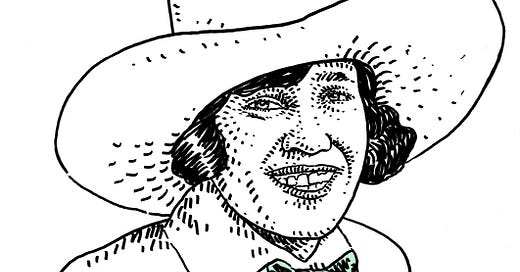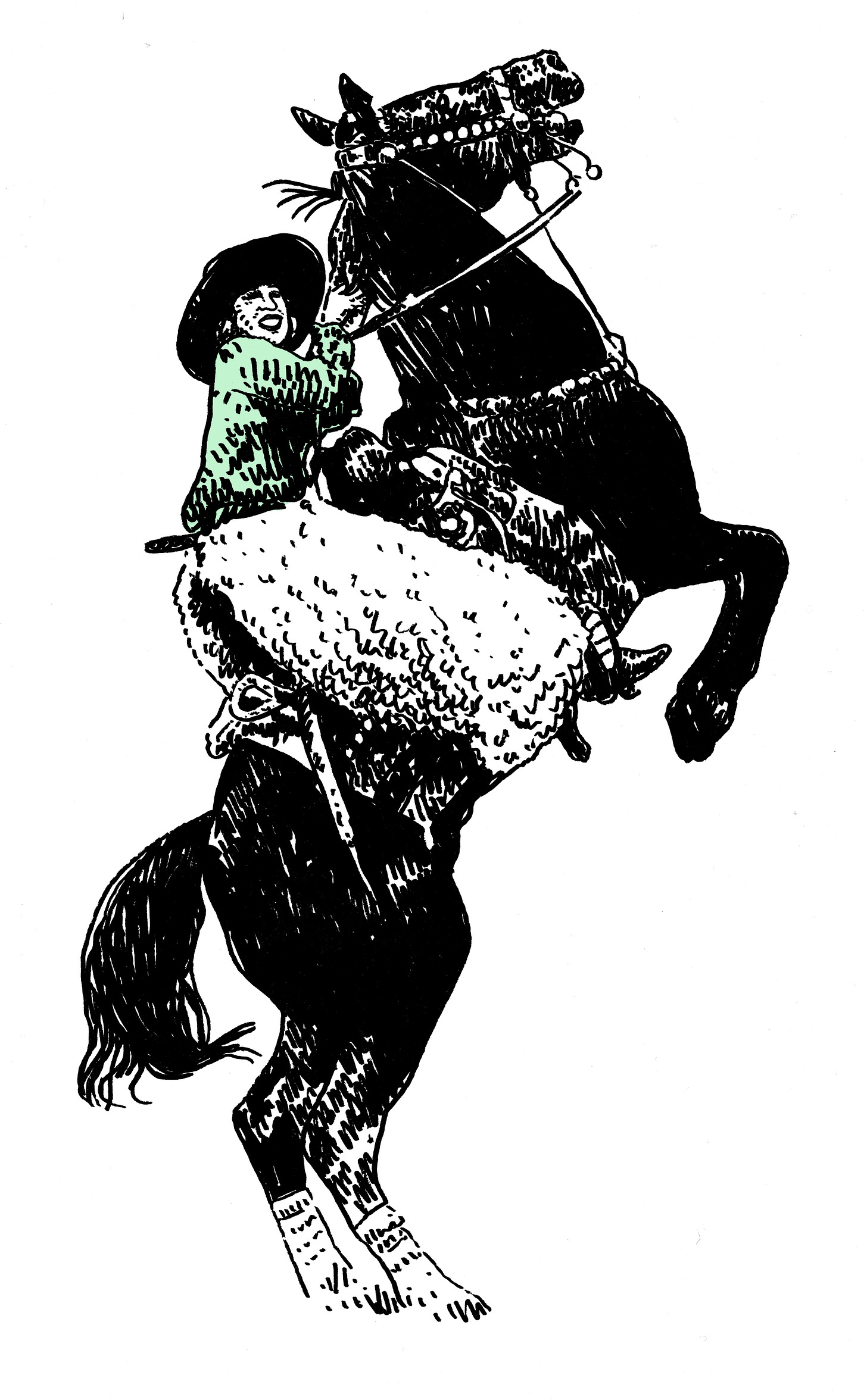Welcome to Sports Stories, a publication at the intersection of sports and history. Sports Stories is written by Eric Nusbaum, illustrated by Adam Villacin, and delivered to your inbox every Tuesday.
If you’re not already a subscriber, please consider signing up here — we have both free and paid options. If you enjoy Sports Stories, please share it with your friends. Word of mouth is our best (and only) means of publicity.
This week’s newsletter is about a woman named Tad Lucas, who is widely regarded as one of the greatest cowgirls to ever live. But it’s also about the magic of history and the millions of little things that have to happen for us as spectators to enjoy a single moment of transcendence, like Tad Lucas jumping her horse over a car. Sports are a miracle. A life like the one Tad Lucas lived is a miracle.
Tad was born Barbara Inez Barnes in a tiny town called Cody, Nebraska in 1902. She was the youngest of her father’s 24 children across two marriages. As a baby, she had a funny way of crawling across the floor, and her family started calling her Tadpole. Soon enough, Tadpole became Tad.
The Barnes family were horse people, and Tad grew up among the animals.
It’s commonly known that horses were introduced to North America in the 15th century by Spanish conquistadors like Columbus and Cortés. But it was actually more of a reintroduction. These days scientists who study fossils believe that the Equus family of animals is in fact native to North America. Wild horses spread from North America to Asia and Europe millions of years ago. Then, during the Ice Age, they went extinct in North America, but continued to thrive elsewhere.
I share all this only because it’s remarkable to think of what had to happen for Tad Lucas to get on a horse as a young girl, and then grow into a rodeo star as a young woman. A very brief and incomplete summary: Horses had to survive and evolve for millions of years in Europe and Asia; tribes in what is now Kazakhstan had to domesticate them 5,000-ish years ago; the Spaniards had to bring them back across the ocean on ships; Native American nations had to trade for them and develop their own horse cultures; those cultures had to be appropriated by white settler cultures and lead us, by way of the 19th century cattle industry, which is part of what drew Tad’s family to a ranch in rural Nebraska and also led directly to the thing we now know as the rodeo.
But young Tad was probably not thinking about any of this. She was probably just thinking about how much she loved riding horses. Years later, she would say that she could never remember a time before she could ride. Tad competed around Nebraska in races and contests. By the time she was about 16, she left home to take off with a traveling Wild Wild West show. It doesn’t feel as though this should be the case, but in 1918, many of the folks we now think of as old time western figures like Wyatt Earp and Annie Oakley were still alive. Buffalo Bill Cody himself only died in 1917. The old west was not so old when Tad was starting out.
Oakley had been a part of Buffalo Bill Cody’s touring cowboy show. In the late 19th and early 20th century, these shows increasingly featured women -- as sharpshooters like Oakley, trick riders, and bronco busters. This was where Tad fit in. But traveling shows were only the beginning for her. According to this fascinating Texas Monthly story, while traveling the country and putting on cowboy shows, Tad came to be mentored by a family of Cossack trick riders.
I admit that I paused when I read that Tad had been mentored by Cossacks. I mean…what were Cossacks doing on the rodeo circuit in the American West? Well it turns out, these were not Cossacks, but Georgians, and that horsemen from the country of Georgia had indeed been a big part of American cowboy culture beginning in about the 1890s, when a troupe came over for the Chicago World’s Fair and simply never left. They were only called Cossacks for marketing reasons. These not-Cossacks are a good reminder that even the most seemingly insular and regional sports are nothing of the sort.
In the early 1920s, Tad moved on from the touring exhibitions and into the growing field of competitive rodeo. She married a cowboy named Buck Lucas and moved to Fort Worth, Texas, where she would spend the rest of her life. Together, Tad and Buck hit the major western rodeos like the Calgary Stampede and Frontier Days in Cheyenne, Wyoming. The rodeos always featured events for women.
As the sport gained popularity and events were staged in major East Coast cities like New York and Chicago, and even at Wembley Stadium in London, Tad became a star. She won contest after contest, brought in armloads of trophies and prize money, and was celebrated for performing outrageously dangerous stunts: standing on her saddle, dragging behind her horse in all kinds of dramatic and compromising positions, and even dipping under the horse’s belly and back up the other side mid-gallup. She was also known to leap her horse over a car. In 1933, Tad shattered her arm during a stunt and was forced to wear a cast for three years.
It wasn’t just the riding either: Tad raised and trained her own horses, just as she had as a girl in Nebraska. She and Buck also taught their daughter Mitzi to ride. When Mitzi was a baby, Tad would place her in the crown of her cowboy hat, and cradle the hat as she rode around the arena.
In the 1940s, singing cowboy Gene Autry took over the American rodeo circuit. Among other things, he did away with women’s events. He opted instead to relegate women to demonstration and pageantry roles, essentially using the rodeo to reinforce the image he sold in his films of a heroic (male) cowboy coming to the rescue of helpless women. “Although the cowgirls in Autry’s productions rode quite well, they remained passive, gentle, and ultimately dependent on the cowboys for their success, just like the women in his films,” wrote cowgirl scholar Mary Lou LeCompte in the Journal of Sport History.
In response, some women promoters began to put on all-cowgirl rodeos. Then In 1948, Tad Lucas and 37 of her colleagues decided to go a step further: they started the Girls Rodeo Association. The GRA quickly established itself as a vibrant promoter of women in rodeo, hosting events, and putting up prize money. In 1955, the GRA reached an agreement with its male equivalent, the Rodeo Cowboys Association, to sanction women’s events at their rodeos.
Tad Lucas retired from the rodeo in 1958. (Apparently, she would have kept riding, but didn’t feel like training another horse.) In the ensuing decades, she was inducted into every Hall of Fame a rodeo cowgirl or cowboy could be inducted into. Her daughter Mitzi became a highly decorated rodeo cowgirl as well. Tad passed away in 1990. She was 88 years old.
Think of all that had to happen to make a life like hers possible. Think of all that is possible because of a life like hers.
Related Reading:
For an overview on Tad Lucas, I would start with this quick rundown by Mary Lou LeCompte, this story by Lonn Taylor of Texas Monthly, or this one by Bobbie Jean Sawyer for Wide Open Country. I also dug this post from a local Fort Worth cycling blog called Hometown by Handlebar (it features tons of great newspaper clips) and this story about Tad’s daughter Mitzi from the TCU alumni magazine.
To learn more about rodeo cowgirls, I’d start with this timeline from American Cowboy, then move onto this history from Wrangler Network. The GRA founded by Tad and her colleagues is now a vastly larger enterprise called the Women’s Professional Rodeo Association. Their biggest event these days is barrel racing, which did not become popular until after Tad’s career was over.
My favorite read on rodeo cowgirls (and how Gene Autry put them briefly out of business) is the aforementioned article by Mary Lou LeCompte from the always-fascinating Journal of Sport History. The full title is “Home on the Range: Women in Professional Rodeo, 1929-1947.” You can read it for free if you create an account on JSTOR. Dr. LeCompte herself, by the way, is a member of the National Cowgirl Hall of Fame, for her extensive scholarship on women in rodeo.
Also: there’s a book out there on the Georgian (not Cossack) horsemen in the American West. I hope to one day pick it up. But if anybody wants to read it and report back, I would absolutely love to hear your thoughts.
Thanks for reading Sports Stories. We’ll see you next week.




